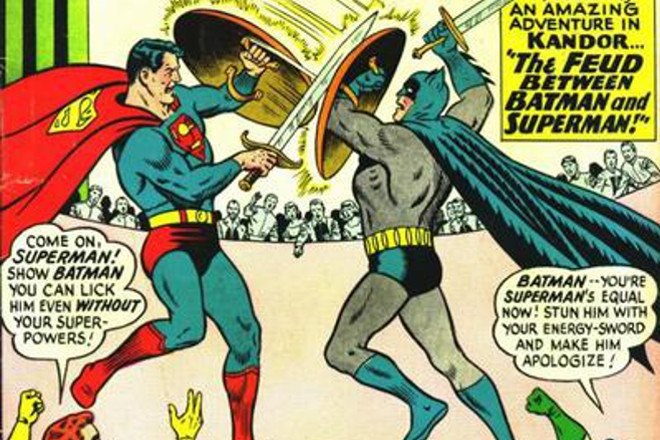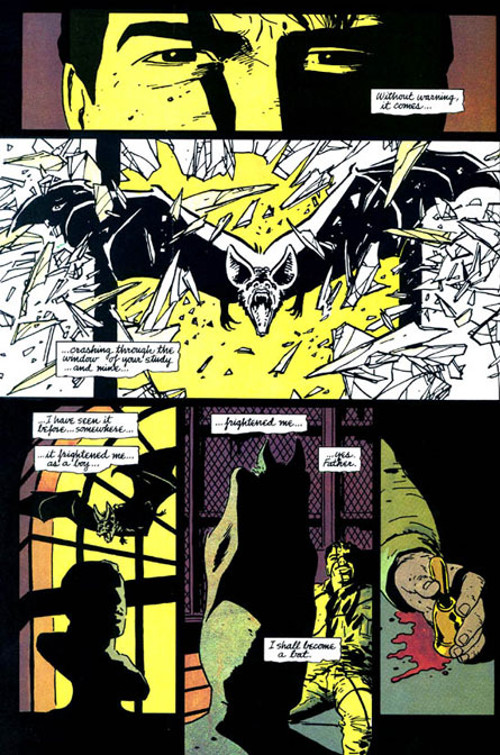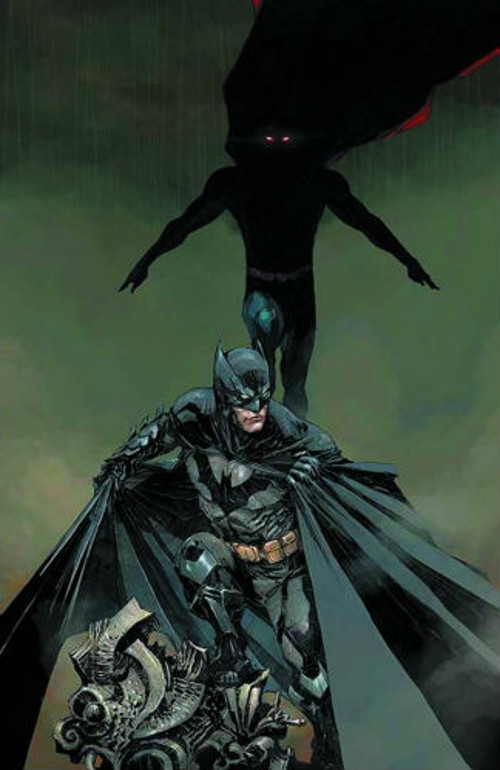Super Best Friends: The Long-Term Relationship Of Batman And Superman
Think the news of Batman featuring in Man Of Steel 2 is just a cheap cash-in? Think again.

This is a re-post from September 2013. You can now watch the first trailer for Superman v Batman here.
–
With the backlash of ‘Batfleck‘ still echoing through internet forums, Facebook statuses, casual conversation and most news channels, it’s about time to take pause and remember that ‘HOLY FUCK SUPERMAN AND BATMAN WILL BE IN THE SAME MOVIE!’
The news is exciting, but somehow not everyone’s into it. Some say it’s just a financially motivated, marketing gimmick, and sure, Man Of Steel fell short of the magical billion mark at the box office so introducing Batman (whose franchise is a goldmine) to its sequel makes sense. But is it shameless and exploitative? Not at all.
Not only is it a smart choice to help set up a future Justice League film, but more importantly, the relationship between Batman and Superman is one of the richest in comics. The two of them have been teaming up together since 1952. Let that sink in. Their relationship is over 61 years old, and in that time (though the average moviegoer might not quite know it yet), it’s become more than worthy of the silver screen.
–
The origins of a super friendship
When superhero comics were first released in the late ’30s, they came out in little anthology issues. For example, in an Action Comics book, you’d normally have a storyline about Superman, then Zatara The Magician, a few sci-fi or pirate tales, and then maybe a war story. One such anthology was World’s Finest Comics, which began publication in 1941.
Detective Comics Inc., now DC, owned the rights to both Superman and Batman, and what made World’s Finest unique was that it featured stories about them both. Though the covers suggested otherwise, consistently showing Superman, Batman and Robin hanging out — on volume #3’s cover they’re playing baseball, on #21 they’re high-fiving each other, and on #60 they’re water-skiing with babes — their stories were always separate. It wasn’t until the ’50s that they finally teamed up. This was a fiscal decision; sales were down and audiences seemed over superheroes. The result was Superman #76, published in June 1952, the first time Clark and Bruce met.
The duo met while on vacation on a luxury cruise. With the ocean liner overbooked, Clark Kent and Bruce Wayne were forced to share the same room. When a fire started onboard, the two inadvertently walked in on each other changing into spandex. It’s cute, corny and ridiculous, a great introduction to the pair that focuses on their odd couple dynamic, and from World’s Finest #76 onwards, the series became solely devoted to their team-ups. Over the next few decades the two fought aliens, repeatedly travelled back in time, duelled each other with swords and shields, and even bet on a boxing match between the Joker and Lex Luthor. The stories were pulpy, fun and camp, and much closer to Adam West’s televised Batman than anything we’ve seen in cinemas.
–
A dark turn
Though they could be disarmingly violent and frequently sexist, the duo possessed a sense of innocence that’s world’s apart from the characters we know today. Throughout the ’80s, comics lost favour with younger audiences, leading the industry to become more adult, more mature and more complex. Reworked by the now legendary writers John Byrne, Alan Moore, Grant Morrison and Frank Miller, Batman’s ‘dark knight’ identity came to the fore. It was in this period that Jason Todd (the second Robin) was brutally murdered, Arkham Asylum showed Batman more at home in the madhouse than on the streets, and two of the most influential bat books of all time were released: Frank Miller’s Batman: Year One and The Dark Knight Returns.
Superman changed, too. He didn’t become ‘dark’, but he was confronted with serious moral quandaries. The old Superman idealism couldn’t quite cut it anymore and was nostalgically concluded in Alan Moore’s 1986 comic Whatever Happened To The Man Of Tomorrow, before Superman was rebooted in John Byrne’s series The Man Of Steel. Byrne focused on how Superman could fit into the modern world and the challenges he would face, most notably by having Lex Luthor graduate from a petty mob boss to an industrialist billionaire. How can Superman even begin to combat something like a multinational corporation, and with almost absolute power, what should and shouldn’t he personally intervene in?
–
Diff’rent strokes
This is when the relationship between Batman and Superman gets intellectually interesting. There’s an inherent divide between them: While Batman walks among the sweat, cigarettes, booze, sex and bloodstains of urban life, Superman soars through blue skies. Superman sees the best in us, Batman sees the worst; the optimist and the pessimist, the idealist and the realist. Though they both fight crime and injustice, they do so from two completely different standpoints. A great example of this occurred recently in Greg Pak’s comic Batman/Superman, released this past June.
In the opening pages of the first issue, we see a boy being bullied, ruthlessly getting the shit kicked out of him in a park, while Bruce watches. Clark appears and intervenes yelling at the kids to stop. They scram and the boy flips Clark the bird. Clark asks how Bruce could just sit there and do nothing, and Bruce replies that he was waiting for the day the boy hit back and now tomorrow’s beating will be worse. Batman understands that doing the ‘right’ thing isn’t always best, but on some level we still love Superman for doing it anyway. It doesn’t lessen either of them, as much as it posits some pretty deep ethical questions.
–
A modern reunion
With this counterbalance, the days of the two playing tennis and drinking lemonade together are long gone. These days, they’re much more likely to brawl. With Superman being more powerful than any villain from Batman’s rogues gallery, Batman is terrified of the danger Superman poses to mankind should he attempt to remake the world as he sees fit. It’s this tension — tied to their ideological stances — that finds them continuously at odds in the modern age, and with Warner Bros announcing Man Of Steel 2 under the tentative title ‘Batman Vs. Superman’, it’s guaranteed that we’re going to see them fight in some way. However that plays out, by the end of the film the two should have realised they’re essentially on the same side.
It sounds odd to say, but only in a team-up can we actually come to understand the two on a personal level. When Bruce Wayne puts on his cowl and deep voice, is he pretending to be Batman, or is Bruce Wayne just Batman masquerading in a business suit? The same question applies to Superman and Clark Kent. When we put Supes and Bats together as friends, we see these identities merge and bleed into each other. They don’t need to posture and they don’t need the other to be a specific someone, which is what we get when the two share their secret identities with lovers or civilians (eg: Alfred nurses and bandages Bruce Wayne, Catwoman wants Batman, Robin needs a father figure, and Lois Lane kind of changes her mind depending on the writer).
And this is what’s so unique about these stories; they explore a kind of intimacy we don’t see elsewhere. At their best, they’re a nuanced look at friendship, two buddies in capes, just chilling in the Batcave.
–
Paul Dalla Rosa sub edits fiction for Farrago Magazine, co-hosts ‘The New Pollution’ podcast, and reads too many comics. Find him on twitter @PaulDallaRosa



